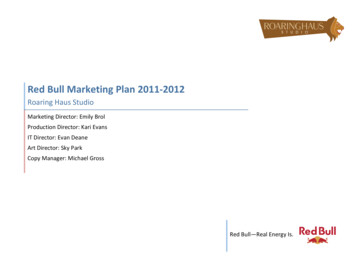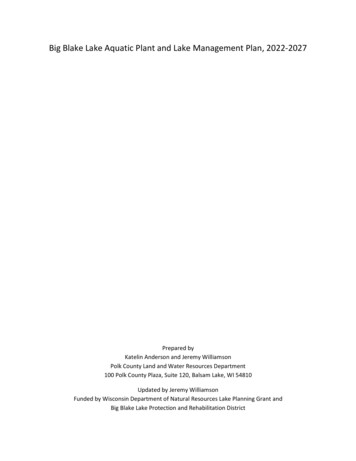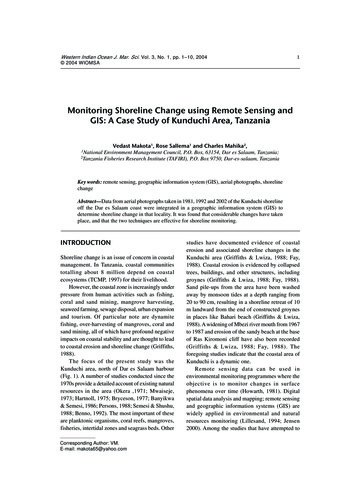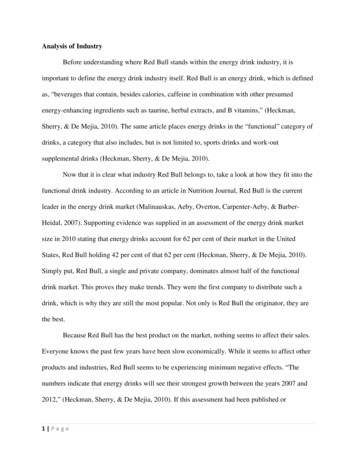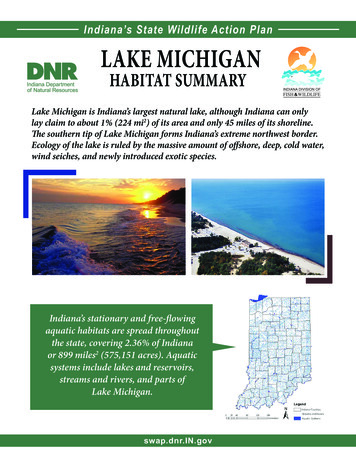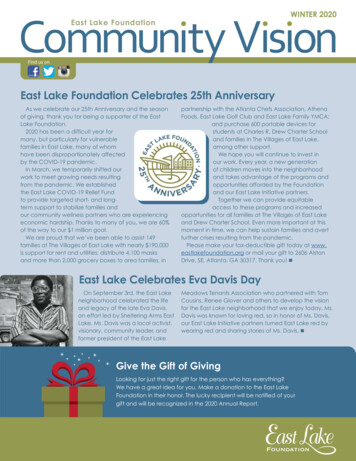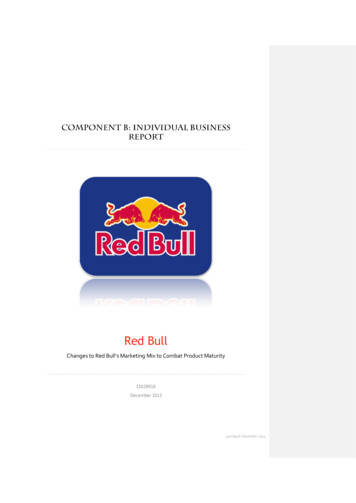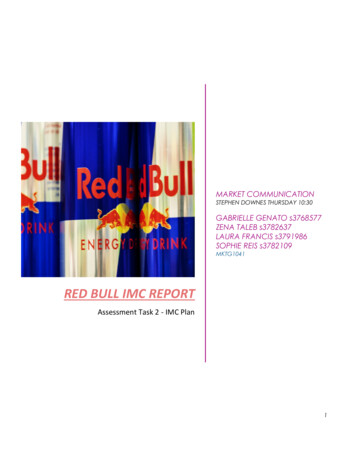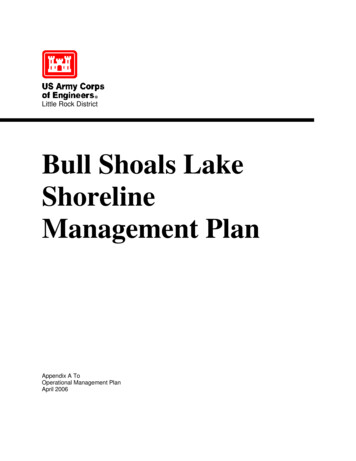
Transcription
Little Rock DistrictBull Shoals LakeShorelineManagement PlanAppendix A ToOperational Management PlanApril 2006
WHITE RIVER WATERSHEDWHITE RIVERBULL SHOALS DAM AND LAKEOPERATIONAL MANAGEMENT PLANFOR BULL SHOALS LAKEAPPENDIX ASHORELINE MANAGEMENT PLANTABLE OF CONTENTSParagraph No.SUBJECTPage No.SECTION I - oject AuthorizationPurposeAuthorityReferencesPrivate Recreation FacilitiesOther Private Shoreline UsesNatural Resources Mission StatementOperational Management PlanFuture Legislation111122222SECTION II - OBJECTIVES OF THE ial ConcessionsLimited Motels/Resorts/CampgroundsPrivate Exclusive UseBackgroundPlan ConversionCurrent Review and UpdateFive-Year Review33344455SECTION III - DESCRIPTION OF THE SHORELINE3-013-023-033-043-053-063-07GeneralLand Acquisition PolicyShoreline/Boundary LinePresent Land UsePrivate DevelopmentExisting AccessPrior CommitmentI7777777
TABLE OF CONTENTSParagraph turalIndian LandsJoint JurisdictionPage No.888SECTION IV - WATER QUALITY4-014-024-034-04GeneralWater Intake StructuresImportanceMarine Sanitation Devices9999SECTION V - SHORELINE ALLOCATION5-015-025-03GeneralAllocationsShoreline Allocation Maps101012SECTION VI - PRIVATE FLOATING FACILITIES AND 6-116-126-136-14GeneralExisting Docks Under PermitFacilities Existing Special ConditionsPermits, Where RequiredPermits, Authority to IssuePermits, Administration ChargePermit TermPosting of Permit NumberDesign of Private Floating FacilitiesCollection of FeesRefund of FeesPermit RevocationRequest for Waiver of ProvisionsAppeals Process1314141515151515151617171717SECTION VII - CONSTRUCTION AND MAINTENANCE REQUIREMENTSFOR PRIVATE FLOATING FACILITIES7-017-02Minimum Design StandardsElectrical ServiceII1818
TABLE OF CONTENTSParagraph No.7-037-04SUBJECTInspectionsFlotationPage No.1818SECTION VIII - OTHER SHORELINE USES BY vate Use of the ShorelineVegetation ModificationAccess PathsLandscapingConditionsErosion ControlBoundary Line and EncroachmentsProhibited Facilities and ActivitiesFees202021212121212223SECTION IX - PERMITS9-019-029-03Shoreline Use PermitsDepartment of the Army PermitsReal Estate Instruments242424SECTION X - OTHER LAND USES10-0110-02Project LandsAdjoining Lands2525SECTION XI - CONCLUSIONS AND RECOMMENDATION11-0111-0211-0311-04Matters Not 6
EXHIBITSEXHIBIT I36 CFR 327.30EXHIBIT IISWLR 1130-2-48, Shoreline Management atCivil Works ProjectsEXHIBIT IIIGrandfathered DocksEXHIBIT IVWildfire Hazard Analysis ProcedureIV
WHITE RIVER WATERSHEDARKANSAS AND MISSOURIBULL SHOALS DAM AND LAKEUPDATED MASTER PLAN FORDEVELOPMENT AND MANAGEMENTBULL SHOALS LAKEAPPENDIX ASHORELINE MANAGEMENT PLANSECTION IINTRODUCTION1-01. Project Authorization. The Bull Shoals Dam and Lake project was authorized by the FloodControl Act of 28 June 1938 (Public Law 761, 75th Congress, 3rd Session), as modified by theFlood Control Act approved 18 August 1941 (Public Law 228, 77th Congress, 1st Session), toinclude the authorization of the project for flood control and generation of hydro-electric power.Section 4 of the Food Control Act approved 22 December 1944, as amended by Section 4 of theFlood Control Act approved 24 July 1946, as amended by Section 209 of the Flood Control Act of1962, as amended by Section 2 of the Land and Water Conservation Fund Act of 1965, and asfurther amended by Section 210 of the Rivers and harbors Flood Control Act of 1968, authorizedthe Department of the Army to provided for recreational use of the lakes under its control.1-02. Purpose. The Shoreline Management Plan establishes policy and furnished guidelines for theprotection and preservation of the desirable environmental characteristics of the Bull Shoals Lakeshoreline while maintaining a balance of private shoreline uses. The plan also considers means ofrestoration of the shoreline where degradation has occurred because of private exclusive use.1-03. Authority. This Appendix was prepared in accordance with the requirements of 36 CFR327.30 dated 1 July 2001 (Exhibit I), ER 1130-2-406 dated 31 October 1990, and SWLR 1130-2-48dated 6 January 2003 (Exhibit II).1-04. References.a. 36 CFR 327.30, dated 1 July 2001, Shoreline Management at Water ResourcesDevelopment Projects Administered by the Chief of Engineers.b. ER 1130-2-406, dated 31 October 1990, Shoreline Management at Civil Works Projects.c. SWLR 1130-2-48, dated 6 January 2003, Shoreline Management at Civil WorksProjects.d. Bull Shoals Lake Shoreline Management Plan Environmental Assessment, dated 30March 2001.1
1-05. Private Recreation Facilities. Private recreation facilities as discussed in this plan includeboat moorage facilities, including mooring buoys, private and community boat docks. Privatefloating facilities used for boat mooring will not exceed the minimum size required to moor theowners’ boat or boats plus a minimum area for storage of oars, life preservers, and other itemsessential to the operation of the watercraft. Private floating facilities will not be used for humanhabitation with the exception of floating cabins authorized under a Real Estate permit.1-06. Other Private Shoreline Uses. Individuals may apply for permits to make minor alterations tovegetation around habitable structures for land-based private uses including vegetationmodification for fire protection, footpath construction and maintenance, planting, and erosioncontrol.1-07. Natural Resources Mission Statement.The U.S. Army Corps of Engineers (USACE) is the steward of the lands and waters atUSACE water resources projects. The Corps' Natural Resources Management Mission is tomanage and conserve those natural resources, consistent with ecosystem management principles,while providing quality public outdoor recreation experiences to serve the needs of present andfuture generations. In all aspects of natural and cultural resources management, the USACEpromotes awareness of environmental values and adheres to sound environmental stewardship,protection, compliance, and restoration practices. The USACE manages for long-term publicaccess to, and the use of, the natural resources in cooperation with other federal, state, and localagencies as well as the private sector. The USACE integrates the management of diverse naturalresource components such as fish, wildlife, forests, grasslands, soil, air, and water with theprovisions of public recreation opportunities. The USACE conserves natural resources andprovides public recreation opportunities that contribute to the quality of American life.1-08. Operational Management Plan. Upon approval, this updated Appendix will become a part ofthe Updated Operational Management Plan for Bull Shoals Lake.1-09. Future Legislation, Regulations and Policies. This plan will incorporate any future legislation,regulations, policies, etc., pertinent to Corps of Engineers Civil Works projects and/or Bull ShoalsLake. Changes of this type will be considered an administrative change and will be incorporatedwithout additional review.2
SECTION IIOBJECTIVES OF THE PLAN2-01. General. Experience has shown that management is necessary to prevent large sections andpossibly all of the shoreline from becoming congested with private floating facilities and land basedprivate uses thereby lost for public use and enjoyment. Management of the shoreline will provideand opportunity for optimum recreational experiences for the maximum number of people andassure compatibility between the recreating public, the environment, and project resources.a. The objectives of this plan are to manage and protect the shoreline, to establish andmaintain acceptable fish and wildlife habitat, aesthetic quality and natural environmentalconditions, and to promote the safe and healthful use of the lake and shoreline for recreationalpurposes by all citizens.b. Boat owners will be encouraged to moor their boats at commercial marinas, utilize drystorage facilities off project lands, or trailer their boats to public launching ramps located within theCorps parks or to one of the launching complexes developed by the county, state, or citygovernments.c. Activities associated with any vegetation modification on public lands require priorapproval and a shoreline use permit from the Operations Project Manager (OPM) at Bull ShoalsLake.2-02. Commercial Concessions. Floating facilities used in connection with commercialconcessions located in the parks are not affected by the shoreline allocations presented in this plan.These commercial operations are effectively controlled under existing Real Estate regulations. Theservices and storage facilities provided by these commercial operations will reduce the need fornumerous individually owned docks along the shoreline.2-03. Limited Motels/Resorts/Campgrounds.Floating facilities used in connection with limited motel/resort/campground leases and boatwith cabin license operations are subject to the shoreline allocations presented in this plan. Due tothe economic impact on existing motel/resorts that already have docks for bona fide guests, theseleases and boat with cabin licenses may be renewed to the present owner or transferred to the nextowner, and the floating facilities serving these operations may remain moored at their presentlocations even though they may not be in areas currently designated for limited development.Expansion or major repairs of existing docks serving these motel and resort leases in areas notapproved for limited development will be considered on a case by case basis. Many smallmotel/resorts are located near the lake specifically for those desiring to use lake waters and if theseoperations did not have docks to accommodate their guests, they would possibly be out of business.3
2-04. Private Exclusive Use. Definition: “Any action, within the context of this rule (36 CFR327.30), which gives special privilege to an family household or group of family households onland or water at a Corps project, that precludes use of those lands or waters by the general public, isconsidered private exclusive shoreline use.” Ownership of private land does not convey anyexclusive rights to the use of the adjoining public lands. It is the objective of this plan to controlprivate exclusive use of public property to the degree necessary to gain maximum benefit for thegeneral public. The issuance of a private shoreline use permit does not convey any real estate,personal property rights, or exclusive use rights to the permit holder. The public's right of accessand their use of the permit area must be maintained and preserved.2-05. Background.a. Development of a preliminary shoreline management plan for Bull Shoals Lake includedan inspection of the entire shoreline, review of photographs and discussions with familyhouseholds, groups and real estate agencies. The initial plan was approved in 1973 with anapproved revision in 1982. This plan was reviewed again and updated with additional publicinvolvement in 1988. The most recent Lakeshore Management Plan for Bull Shoals Lake wasapproved by the Division Engineer, Southwestern, in October 1988.b. Revision of 36 CFR 327.30 in 1990 required the Little Rock District to convert itscurrently approved lakeshore management plans to shoreline management plans. The District’sdraft operating policy for shoreline management was discussed at a series of public workshops heldat Forsyth, Missouri, 4 June 1991; Diamond City, Arkansas, 5 June 1991; and Mountain Home,Arkansas, 6 June 1991. The provisions of the finalized policy, SWLOM 1130-2-33, and theshoreline allocations contained in the most recent approved lakeshore management plan have beenincluded in this Shoreline Management Plan for Bull Shoals Lake. The Shoreline ManagementPlan was approved by the Southwestern Division Office on 1 April 1993.c. In 1994, an update was conducted to recommendation changes in shoreline allocations at18 scattered locations around the lake. A public workshop was held at the Mountain Home ProjectOffice on 23 May 1994 and at Forsyth Missouri on 24 May 1994 to notify the public of theShoreline Management Plan review. The Mountain Home Project Office evaluated 28 rezoningrequest resulting in the approval of 18 requests. The plan was approved on 19 August 1994.2-06. Plan Conversion. After the development of the preliminary plan, a public meeting was heldon 29 November 1972 at Mountain Home, Arkansas. Recommendations and objections werereceived from the public at the meeting and by mail for 30 days following the meeting. In responseto these public comments, a number of shoreline areas were reinspected and reevaluated and arevised plan was developed and furnished to the District Office for final review and was approvedby the District Engineer on 17 January 1974. At that time, applications were once again accepted,preference was given to community mooring facilities over family household-owned docksproposed in allocated areas approaching the maximum density of development. Another publicmeeting was held in Mountain Home on 20 March 1974 to present the final plan and answerquestions from the public. Subsequent issuance of ER 1130-2-406 required approval by theDivision Engineer prior to implementation of the plan as presented in the Appendix.4
2-07. Current Review and Update. During the update of this plan, a public workshop was held on26 October 1999, announcing the plan update and the process that would be followed.Applications for boat dock rezoning were accepted until 1 December 1999. This information wasprovided via news releases, paid legal notices, and posting on the Internet. There were 65 rezoningrequests received and evaluated, 32 were approved.Other public workshops were held on 8, 9, 10 February 2000 to begin collecting issues fromthe public regarding any changes desired in the Bull Shoals Shoreline Management Plan. Thewritten comment period closed on 11 March 2000. Public comments strongly recommendedchange in the following areas:(1) Opposed to elimination factors(2) In support of original request or additional information(3) Irrelevant to SMP reviewThese comments were used to prepare the draft SMP. Changes to the Bull Shoals LakeMaster Plan require that an Environmental Assessment (EA) be prepared to comply with theNational Environmental Policy Act. Since the draft SMP included changes, a contract was issuedto have an EA prepared to study the alternatives recommended as a result of the public commentperiod.A second series of public workshops were held in Mountain Home and Leadhill, Arkansasand Gainesville, Missouri on 23, 24, 25 January 2001. The Operations Manager and Park Managerpresented the draft Shoreline Management Plan and draft Environmental Assessment. Threeoptions were presented for public comment. The deadline for written comments to the SMP andEA was 26 February 2001. A total of 83 persons attended and submitted 49 written comments.Overwhelming support for option 3 was the result of the comments.The following plan implements the required administrative changes to the Bull Shoals plan.These changes bring it in line with other Shoreline Management Plans in the Little Rock District. Itis also responsive to those family households who requested a limited development area during thisreview and would force development of the remaining 79 miles of shoreline already identified forPrivate Floating Facilities before we set aside additional area.The plan as presented in this Appendix reflects the best use of the shoreline based oncurrent public use and needs.2-08. Five-Year Review.a. Shoreline management plans will be reviewed periodically, but no less often than everyfive years, by the district commander to determine the need for update. The plan may besupplemented more frequently should regulations, project operations, project conditions, ormanagement objectives change significantly. The District Engineer may approve minoradministrative revisions to the plan when the revisions are consistent with ER 1130-2-406 or 36CFR 327.30. The addition or deletion of limited development areas is not considered a minor5
revision. Revisions of this nature will require public involvement and approval by the DivisionCommander.b. Rezoning requests will only be considered or accepted in future updates when all thecurrent Limited Development Areas are utilized to the maximum extent permitted by 36 CFR327.30, dated 27 July 1990 or future updates thereof.6
SECTION IIIDESCRIPTION OF THE SHORELINE3-01. General. Bull Shoals Lake is one of a series of five lakes in the Upper White River Basin innorthern Arkansas and southern Missouri. The area is generally wooded and rugged withinteresting geological formations overlooking the winding White River. The lake has an irregularshape with numerous arms and coves, and varies topographically from steep bluffs to gentlysloping points. Much of the shoreline in the upper reaches of the lake, because of its gentle slope,is subject to rapid dewatering when the pool elevation reduces.3-02. Land Acquisition Policy. The real property fee acquisition line for Bull Shoals Lake, as ageneral rule, was blocked out along regular land subdivision or property ownership lines to includeall lands below elevation 695 m.s.l. (mean sea level) or to include the lands required for publicaccess areas.3-03. Shoreline/Boundary Line. At top of mean conservation pool, EL 654, the shoreline of thelake has a total length of 740 miles. As the pool rises to the top of flood control pool, EL 695, theshoreline length increases to 1,050 miles.3-04. Present Land Use. The Bull Shoals project area contains 101,196 acres; 100,090 acresowned in fee and 1,106 acres are managed by flowage easement. The 71,240 acres below theFlood Control Pool elevation and 75 acres required for the dam and appurtenant works areallocated for Project Operations. There are 9,505 acres allocated for recreation-intensive use and22,718 acres for wildlife management, which includes areas located below the Flood Control Poolelevation. The areas below the Flood Control Pool elevation are dually allocated.3-05. Private Development. The area around Bull Shoals Lake is a popular vacation andretirement area. This is evident by the increase in visitation to the lake, from 422,000 in 1952, toalmost 3.8 million in 1992. Subdivision development and home building are both at all-time highsin and around Bull Shoals Lake as is evidenced by the tremendous increase in taxable property inall five counties where the lake is located.3-06. Existing Access. The waters of Bull Shoals Lake are easily accessible to the recreationalboaters and the adjoining property owners alike. In addition to the 41 launching lanes located inthe parks, numerous severed roads around the lake are also used by residents and sportsmen.3-07. Prior Commitment. Private docks have been permitted on Bull Shoals Lake since itsimpoundment began in January 1952. The number of private floating facilities on the lake hascontinued to increase since that time. There are 16 docks on Bull Shoals Lake that are consideredprior commitments and are located in unzoned areas of the shoreline. These grand-fatheredfacilities are listed in Exhibit III by permit number and location.3-08. Historical/Archeological/Cultural. The U.S. Army Corps of Engineers is charged by law(P.L. 96-515 Section 110) and regulation ER 1130-2-540 with the responsibility and efficient7
management of all Historic Properties on lands under its control. ER 1130-2-540 defines the term"Historic Properties" as any prehistoric or historic district, site, building, structure, or objectincluded in or eligible for inclusion in the National Register of Historic Places.3-09. Indian Lands. There are no Indian lands within the boundaries of the Bull Shoals Lakeproject.3-10. Joint Jurisdiction. No other Federal agencies have jurisdiction over administration of theshoreline covered by this plan.8
SECTION IVWATER QUALITY4-01. General. Water quality management is a complex and challenging task due largely to theextensive and varied human activity both in and around the lake. The broad goal of thismanagement responsibility is to promote water quality adequate for safe and healthy public use aswell as conservation of wildlife, fish, and other beneficial aquatic life.4-02. Water Intake Structures. Currently the Marion County Water District is the only commercialwater customer that uses Bull Shoals Lake for public water supply. The shoreline allocation aroundthis area is designated as Prohibited and is shown in blue on the allocation maps.4-03. Importance. Bull Shoals Lake continues to provide a safe and dependable public drinkingand industrial water supply, as well as aquatic habitat, and recreational opportunities. Safeguardingthe water quality of the lake is of utmost importance. The cooperation of all family households,federal, state, and local agencies is necessary in this effort.4-04. Marine Sanitation Devices.a. All permanently installed boat toilets must have a U.S. Coast Guard certified MarineSanitation Devices (MSDs). The use for any type MSD other than a U.S. Coast guard approved"no discharge" type is prohibited. Proof of state certification must be displayed on the vessel.b. The discharge of any type of effluent in the waters of Little Rock District lakes isprohibited.c. Only approved marine pumpout locations may be used.9
SECTION VSHORELINE ALLOCATION5-01. General. Increased development of adjoining private land increases the demand for privatefloating facilities; therefore, it is readily apparent that a plan for systematic development of theshoreline is essential. This approach is intended to protect the natural beauty of the shoreline and tobalance shoreline uses to maximize the benefits for the most users.5-02. Allocations. A comprehensive study of the entire shoreline, involving public participation,resulted in development of a shoreline management plan for Bull Shoals which establishes thefollowing shoreline allocations:a. Limited Developments Areas. Approximately 90 miles of the shoreline is allocated forlimited development. These areas are shown in red on the shoreline allocation maps. Privatefloating facilities, (docks), and vegetation modification (meandering footpath and fire protectiononly) are permitted in areas designated for limited development. Generally, the number of docksthat will be permitted in an area will be limited by spacing a minimum of 100 feet apart in idealshoreline conditions.(1) The density of development in limited development areas will depend upon and beconsistent with the ecological and aesthetic characteristics of the particular area. The density ofdevelopment will not exceed 50 percent of the shoreline allocated for limited development whenthe lake level is at the top of conservation pool. Density will be determined by measuring linear feetof shoreline in the zone and comparing it to the width of the facilities in the water plus associatedmoorage arrangements (anchorage) which restrict the full unobstructed use of that portion of theshoreline. The Operations Project Manager will assess conditions and consider designating thezone for community docks only when the number of docks in a given zone reaches 50 percent ofthe estimated capacity of that zone (at conservation pool elevation) or when development and/orgrowth patterns indicate high demand potential for mooring facilities. Compatibility with existingdocks and adequacy of access roads and parking facilities will be considered before designating azone for community docks only.(2) All United States citizens have an equal opportunity to moor a dock in a limiteddevelopment area provided the area has not reached the maximum density of development. Theapplicant must have legal access to the shoreline either by public road, ownership of adjoiningproperty, or right of access across adjoining property. Legal access to the shoreline is considered tobe within 200 feet of the location of the facility from the government boundary line or an approveddesignated parking area. Public roads will constitute legal access when applying for a permitwithin 200 feet of an existing designated parking area. Approved designated parking areas havebeen identified and are shown on the official shoreline allocation map located at the MountainHome Project Office. In the event that the individual(s) do not own the land adjacent to the facility,then a recorded lease or easement for the access must be provided that allows all current and anyfuture owners of the dock the right of ingress and egress, for at least the duration in which thefacility is present. The holder of the permit must provide the Operations Project Manager proof oflegal access, a plat of the adjoining land that describes the subdivision and access area, as well as, a10
proposal for parking on private property. All dock owners who are not permanent residents of thearea must designate a local party who will be responsible for surveillance over the dock on a 24hour basis.(3) Location on the lake, fluctuation of water level, and other criteria will be thedetermining factors in approval or disapproval of a request in these areas. Designation as a limiteddevelopment area does not guarantee the approval of dock placement, nor that adequate waterdepth is available at all times.(4) Docks will be spaced a minimum of 100 feet apart in ideal shoreline conditions.Compatibility with existing docks and adequacy of access roads and parking facilities will beconsidered before approving additional private floating facilities. Placement should not be madethat would produce a cross-over situation; meaning that an applicant’s facilities (including electricservice and anchor cables) should not go beyond existing neighboring facilities. Cross-oversituations cause community discord and therefore, should be avoided. Only under the most unusualsituations may cross-overs be approved by the Operations Project Manager.b. Public Recreation Areas. Approximately 140 miles of the shoreline is allocated for parksand buffer areas. These areas are shown in green on the shoreline allocation maps. Private floatingfacilities are not permitted within or adjacent to developed or future parks or from the vista of thepark. Family households or groups are not permitted to make any modification of the land form orvegetative characteristics of lands under this allocation. Commercial boat docks and concessionsare permitted in public recreation and buffer areas.c. Protected Shoreline Areas. Approximately 507 miles of the shoreline is allocated forprotected areas. These areas are not represented by color code on the shoreline allocation maps. Amajority of the shoreline on Bull Shoals Lake is designated as protected area. Private floatingfacilities are not permitted in protected shoreline areas. These areas were designated to protectaesthetic, environmental, and fish and wildlife values. Other reaches of the shoreline were includedunder this allocation for physical protection, reasons including shallow areas and reaches of theshoreline subject to exposure to winds or currents. Land access and boating are permitted along theshoreline with these allocations as long as aesthetic, environmental and natural resource values arenot damaged or destroyed. Modification of the land form or vegetation may be permitted afterconsideration of the effects on the environmental and physical characteristics of the area by theOperations Project Manager. Rights of way for launching complexes across shoreline allocated asprotected areas will be considered on a case by case basis. Shoreline not designated under anotherallocation on the enclosed maps is considered protected shoreline area.d. Prohibited Access Areas. These blue areas are not represented by a color on the shorelineallocation maps. Private floating facilities and other shoreline uses are prohibited in areas adjacentto the dam and the Marion County Regional Water District Intake Structure. There isapproximately 1 mile allocated as prohibited access areas.11
5-03. Shoreline Allocation Maps. A master map of the shoreline is on display at Mountain HomeProject Office at Mountain Home, Arkansas. The master map shows further designations withinthe protected and prohibited shoreline areas; i.e. scenic, shallow, natural, etc.12
SECTION VIPRIVATE FLOATING FACILITIES AND CONDITIONS6-01. General. The following guidance is provided to assure the most effective use of the limitedamount of shoreline set aside for the mooring of private floating facilities and other privateshoreline uses.a. A separate family household may have a maximum of two slips in any dock and may notown an interest in more than one facility. Valid state boat registration will be necessary to verifyslip needs. A family household is defined as family households living at the same address. Afamily household may have only one of the two following items to preclude usurpation of theshoreline. The applicant may have either:(1) A permit for a private floating facility.(2) Ownership of slips in a community dock.b. The Operations Project Manager will approve the size, configuration, and anchoring planfor docks. The maximum size of private floating facilities will be 20 slips for safety reasons and toassure maneuverability of the dock during periods of pool fluctuation. Existing docks larger than20 slips will be grand-fathered if safely maintained and shoreline is not needed for a higherpurpose.c. Docks may not extend out from the shore more than one-third of the cove width atseasonal conservation pool level.d. Private floating facilities will not exceed the minimum size required to moor the owner'sboat(s) (not to exceed three feet beyond ves
a. 36 CFR 327.30, dated 1 July 2001, Shoreline Management at Water Resources Development Projects Administered by the Chief of Engineers. b. ER 1130-2-406, dated 31 October 1990, Shoreline Management at Civil Works Projects. c. SWLR 1130-2-48, dated 6 January 2003, Shoreline Management at Civil Works Projects. d.
